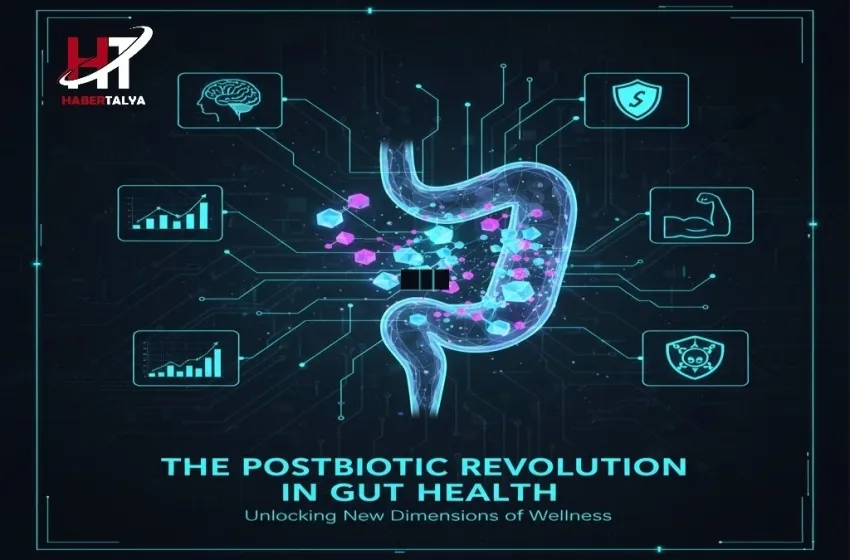Moving beyond probiotics: explore postbiotics and short-chain fatty acids (SCFAs) as key therapeutic molecules regulating gut health, immunity, and the gut-brain axis.
The study of the human gut health has entered a new era, shifting focus from the presence of live organisms (probiotics) to the potent chemical messengers they produce. This shift marks the rise of the Postbiotic Revolution. Postbiotics are defined as "a preparation of inanimate microorganisms and/or their components that confers a health benefit on the host." Essentially, they are the functional output—the therapeutic molecules—of the microbiome science engine.
This article explores the mechanisms and therapeutic implications of this emerging class of biotics, specifically moving beyond probiotics to the functional molecules (postbiotics like SCFAs) produced by gut bacteria and their therapeutic roles. It highlights how these powerful metabolites, particularly short-chain fatty acids (SCFAs), act as key communicators along the gut-brain axis and regulate systemic health far beyond the digestive tract.
Moving Beyond Probiotics: Defining Postbiotics
For decades, the field of microbiome science centered on probiotics—live bacteria introduced to the gut health ecosystem. While beneficial, probiotics face challenges related to viability, shelf stability, and survival in the harsh gastrointestinal environment. Postbiotics circumvent these issues, offering a more stable, predictable, and standardized approach to leveraging the therapeutic molecules of the gut.
What are Postbiotics?
Postbiotics encompass a heterogeneous group of substances generated during the fermentation process by gut microbes or released after microbial cell lysis. Key components of postbiotics include:
- Short-Chain Fatty Acids (SCFAs): The most well-studied and functionally significant class.
- Cell Wall Components: Peptidoglycans, teichoic acids, and lipopolysaccharides (LPS).
- Functional Proteins and Peptides: Including enzymes and bacteriocins (antimicrobial peptides).
- Exopolysaccharides (EPS): Carbohydrate polymers with immunomodulatory and prebiotic-like effects.
- Vitamins and Amino Acids: Essential nutrients synthesized by the bacteria.
By delivering the bioactive compounds directly, postbiotics ensure that the host receives the functional benefits without relying on the survival and proliferation of live bacteria, a significant advantage for consistency and quality control in commercial products.
The Powerhouse: Short-Chain Fatty Acids (SCFAs)
The most pivotal therapeutic molecules derived from microbial fermentation are short-chain fatty acids (SCFAs)—primarily acetate, propionate, and butyrate. These SCFAs are produced when beneficial bacteria, particularly species like Faecalibacterium prausnitzii and Roseburia, ferment dietary fiber, resistant starch, and other non-digestible carbohydrates in the colon.
1. Butyrate: The Gut Barrier's Fuel
Butyrate is arguably the most critical SCFA for gut health. Its primary roles are:
- Colonocyte Energy Source: Butyrate serves as the preferred energy source for colonocytes (the cells lining the colon). By providing fuel, it ensures the health, proliferation, and integrity of the epithelial barrier.
- Strengthening the Barrier: It enhances the expression of tight junction proteins (e.g., zonulin, occludin), physically "sealing" the gap between intestinal cells. This is crucial for preventing "leaky gut" (increased intestinal permeability), which is implicated in numerous inflammatory conditions.
- Anti-inflammatory Effects: Butyrate acts as a potent anti-inflammatory agent by inhibiting the activity of the transcription factor NF-κB, a central regulator of inflammatory responses in the gut.
2. Acetate and Propionate: Systemic Messengers
While butyrate stays largely within the colon, acetate and propionate are absorbed into the bloodstream, where they exert powerful systemic effects:
- Acetate: The most abundant SCFA, acetate travels to the liver and muscles where it plays a role in energy metabolism and is a precursor for lipid synthesis.
- Propionate: Propionate travels to the liver, where it is involved in gluconeogenesis (the creation of glucose), helping to regulate blood sugar levels. It also plays a key role in stimulating satiety hormones, thus influencing appetite and weight management.
Therapeutic Roles of Postbiotics
The regulatory impact of Postbiotics extends far beyond the digestive tract, positioning them as essential therapeutic molecules with potential applications across multiple chronic diseases.
A. Immune System Modulation
SCFAs are powerful immunoregulatory compounds. They interact with specific receptors on host cells, namely G-protein coupled receptors (GPR41, GPR43, and GPR109A), and act as histone deacetylase (HDAC) inhibitors.
- Treg Cell Production: Butyrate, by inhibiting HDACs, promotes the differentiation of regulatory T-cells (Tregs). Tregs are crucial immune cells that suppress excessive immune responses, helping to maintain immune tolerance and prevent inflammatory diseases, such as Inflammatory Bowel Disease (IBD) and allergies.
- Mucosal Immunity: Postbiotics strengthen the mucosal immune system by promoting the secretion of antimicrobial peptides (like defensins) and influencing the composition of gut-associated lymphoid tissue (GALT).
B. The Gut-Brain Axis Communication
The bidirectional communication pathway known as the gut-brain axis links the central nervous system (CNS) to the enteric nervous system (ENS) via neural, immune, and humoral signals. Postbiotics are primary communicators along this axis.
- Neurotransmitter Synthesis: SCFAs can influence the synthesis of key neurotransmitters. Butyrate, for instance, can cross the blood-brain barrier (BBB) and directly impact brain function. The presence of SCFAs also stimulates gut cells (enterochromaffin cells) to produce serotonin, a key neurotransmitter involved in mood regulation.
- Neuroinflammation: Postbiotics, particularly butyrate, exhibit neuroprotective effects by reducing inflammation in the brain. They have been shown in studies to modulate microglial activation (the brain's immune cells) and alleviate neuroinflammation, offering promising avenues for treating cognitive impairment and neurological disorders.
- HPA Axis Regulation: Postbiotics can modulate the hypothalamic-pituitary-adrenal (HPA) axis, which governs the body's stress response, potentially offering novel treatments for anxiety and depression.
C. Metabolic and Cardiovascular Health
Through their systemic absorption, Postbiotics impact major metabolic pathways:
- Glucose Homeostasis: SCFAs, particularly propionate and acetate, improve insulin sensitivity and help regulate blood glucose levels. Propionate's role in hepatic gluconeogenesis can ensure stable energy supply.
- Lipid Metabolism: SCFAs can reduce cholesterol synthesis in the liver and influence fat storage, offering potential benefits for managing obesity and cardiovascular risk. Studies link higher dietary fiber intake—and thus higher SCFA production—to reduced levels of LDL cholesterol.
Conclusion: The Future is Functional
The shift from live organisms to their therapeutic molecules—the Postbiotics—represents a paradigm change in microbiome science. By providing stable, precise doses of functional compounds like short-chain fatty acids (SCFAs), the industry can deliver targeted benefits to gut health, the immune system, and the gut-brain axis.
The Postbiotic Revolution promises to unlock highly standardized and scalable solutions for chronic conditions ranging from Inflammatory Bowel Disease to neurological and metabolic disorders. As research continues to elucidate the precise molecular targets, Postbiotics are set to become the next generation of biotics, moving the field one step closer to truly personalized and effective gut health management.
Frequently Asked Questions (FAQ)
How are Postbiotics different from Prebiotics and Probiotics?
Probiotics are live beneficial bacteria; Prebiotics are non-digestible fibers that feed the bacteria; and Postbiotics are the non-living therapeutic molecules (like SCFAs) produced by the bacteria, offering a stable and predictable way to confer gut health benefits.
What are the three primary short-chain fatty acids (SCFAs) and what is their main function?
The three primary SCFAs are Butyrate, Acetate, and Propionate. Their main function is to strengthen the intestinal barrier, provide energy for colon cells (butyrate), and regulate systemic processes like glucose and lipid metabolism (acetate and propionate).
How do Postbiotics affect the gut-brain axis?
Postbiotics are crucial communicators in the gut-brain axis by influencing neurotransmitter synthesis (like serotonin), regulating the body's stress response (HPA axis), and reducing neuroinflammation, which can impact mood, cognition, and behavior.
Why are Postbiotics considered more stable than Probiotics?
Postbiotics consist of inanimate (non-living) microbial components or metabolites, making them highly stable. They do not require refrigeration and are resistant to harsh environments like stomach acid, ensuring consistent dose delivery into the gut.
What role does Butyrate play in intestinal barrier integrity?
Butyrate, an SCFA, is the primary energy source for colonocytes. By nourishing these cells, it helps tighten the junctions between them (tight junction proteins), physically strengthening the intestinal barrier to prevent harmful substances from leaking into the bloodstream.
How do Postbiotics specifically modulate the immune system in the gut?
Postbiotics modulate the immune system primarily through SCFAs. Butyrate acts as an HDAC inhibitor, promoting the differentiation of anti-inflammatory Regulatory T-cells (Tregs). SCFAs also interact with receptors (GPRs) on immune cells to suppress pro-inflammatory signaling pathways.
Can Postbiotics be used to treat Inflammatory Bowel Disease (IBD)?
Research suggests Postbiotics, particularly SCFAs like butyrate, hold therapeutic promise for IBD. IBD patients often have lower levels of SCFA-producing bacteria. Supplementation can help reduce inflammation, restore gut health, and enhance the intestinal barrier, often acting as a supportive therapy.
What are the non-SCFA therapeutic molecules found in Postbiotics?
Beyond short-chain fatty acids (SCFAs), non-SCFA therapeutic molecules in Postbiotics include bacteriocins (antimicrobial peptides), which inhibit pathogens; exopolysaccharides (EPS), which have immunomodulatory effects; and cell wall fragments (like peptidoglycans), which interact directly with host immune receptors.
How do Postbiotics like SCFAs regulate metabolic health?
Systemically absorbed SCFAs (acetate and propionate) travel to the liver where they influence lipid and glucose metabolism. They can improve insulin sensitivity, regulate blood sugar through gluconeogenesis, and promote satiety, making them relevant for managing type 2 diabetes and obesity.
What makes Postbiotics a focus of "next-generation therapeutics" in microbiome science?
The focus on Postbiotics in microbiome science is driven by their stability, precision, and safety profile. They deliver specific, measurable therapeutic molecules without the risk of introducing live bacteria, making them ideal candidates for regulated pharmaceutical and medical applications.






























